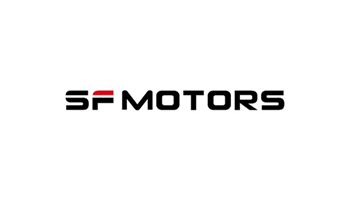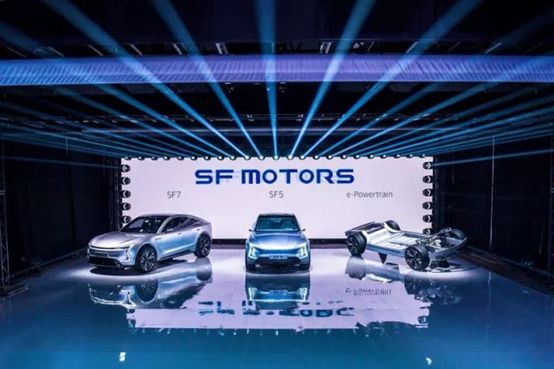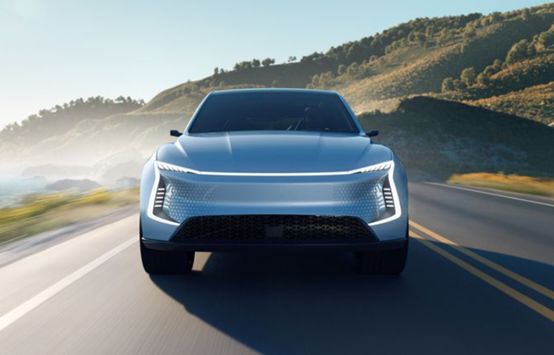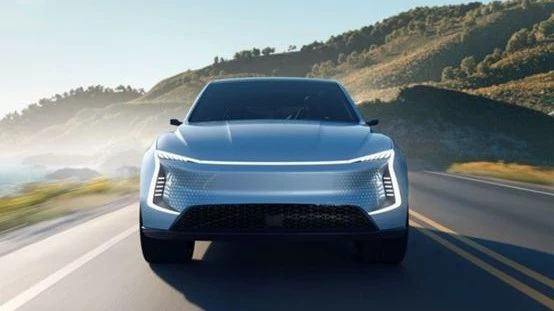After the uncertain future of Faraday Future, the second Chinese-invested automotive company, SF MOTORS, has emerged in the United States.

SF MOTORS has been in the limelight in foreign media for a week, starting from March 29, when it released two electric SUVs in Silicon Valley.
Chinese-Funded SF Motors was the description used in the reports on this launch event held at Santa Clara, California, but where does SF’s fund come from?
The media has been scrutinizing SF for the past few days. Even though SF’s official website’s promotional statement does not mention anything, everyone knows the truth.
Simply put, SF MOTORS was registered in Silicon Valley in January 2016, and the main initial investor was Chongqing Sokon Industry Group Co., Ltd. (SOKON), a Chinese company with a focus on developing high-end electric vehicles.
If you are not familiar with SOKON, you may have heard of Dongfeng Xiaokang, which was once endorsed by Wang Baoqiang. Xiaokang Weimian and Dongfeng Fengguang SUV are brands under SOKON’s joint venture with Dongfeng Motors.
Forgive me for not paying enough attention to our domestic brands on weekdays, but when I first saw SF, I instantly thought of Shunfeng (SF).
Although SF seems to have emerged out of nowhere, it can be seen from the past information that it is the result of years of careful operation by SOKON.
This achievement has truly ignited Chinese car companies in the United States.
Vision of Laying Out Fifteen Years Ahead
SF cannot be traced to any history, as it is a brand new company that was only established recently. However, its biggest investor, SOKON, has many stories.
SOKON’s predecessor was the Chongqing Yuan Group, established in 2002, which manufactured and sold motorcycles. In 2003, YuaAfter joint venture with Dongfeng to produce cars, Chongqing Yu’an established Xiaokang Power in 2004 to produce car engines. This is having the heart of a fuel car in your own hands.
In 2007, the business was integrated to form Xiaokang Group. In 2014, they started production of Dongfeng Fengguang series and entered China’s SUV market, known as the car blue sea. In 2016, Xiaokang became listed on the stock exchange.
In 2017, many companies fought for the pure electric passenger car production license issued by the National Development and Reform Commission, with 15 companies eventually winning out. One of them, called Chongqing Jinkang, is a wholly-owned subsidiary of Xiaokang.
And now, this year, in Silicon Valley on the other side of the ocean, Xiaokang rolled out SF, transforming from selling low-priced fuel cars to high-end electric cars.
Along the way, Xiaokang Group has carefully been keeping an eye on the big picture.
Buy, Buy, Buy – The First Step towards the Magnificent Turnaround
Of course, the transformation from selling low-priced fuel cars to high-end electric cars is not that easy, and Xiaokang has spared no effort in managing this transformation.
In 2016, when Xiaokang Group established Chongqing Jinkang, it began seeking ways to enter the high-end electric car market.
Firstly, Xiaokang chose a good location in order to create a new image. Silicon Valley in California, as a unique choice, is open, advanced, inclusive, and a pioneering center of entrepreneurship. When Xiaokang established Jinkang in China, it also invested $30 million in SF in Silicon Valley.
Secondly, just as Xiaokang had to grab the heart of the engine of a fuel car when making combustion engine cars, it also had to seize the heart of the battery for electric cars when making electric cars.
Therefore, Xiaokang’s first decision for the magnificent turnaround was to seek the acquisition of battery companies. Time waits for no one, if they can make a good purchase, it is equal to sitting on a rocket. In contrast, self-development is akin to taking a slow and risky train.
For those making high-end electric cars, there is only one competitor to aim for – Tesla. After registering SF in 2016, the first target that Xiaokang was interested in was AC Propulsion, the California-based engineering company that was authorized to use lithium-ion battery technology in the first generation of Tesla Roadsters. However, the acquisition proposal was not accepted.
Although the acquisition was blocked, Xiaokang has made progress in its talent reserve. In September 2016, Xiaokang Group hired Martin Eberhard as its strategic consultant. Martin Eberhard is one of the co-founders of Tesla and founded the electric vehicle battery system research and development company, InEVit. After serving as a consultant for one year, Martin Eberhard convinced Xiaokang to acquire his company. Xiaokang spent $33 million to acquire the heart of the electric car and also incorporated Martin Eberhard and his team.Before acquiring a battery R&D company, Xiaokang spent $110 million in September 2017 to acquire the AMG civilian vehicle factory located in Mishawaka, Indiana, USA and completed the layout of the SF factory. AMG was previously a factory that produced the Hummer H2 and Mercedes-Benz R-Class models.
Through such acquisitions, SF has successfully climbed onto the stage of the new energy vehicle power in Silicon Valley under Xiaokang’s control.
Many people may wonder if Xiaokang has such strong funds to make such a big acquisition.
Xiaokang is controlled by a family. The patriarch of this family is Zhang Xinghai, the chairman and CEO of Xiaokang.
In 2016, Xiaokang, controlled by the Zhang family, was listed on the A-share of China. In 2017, the wealth of the Zhang family broke through RMB 10 billion and reached RMB 14.954 billion, ranking fourth on the Chongqing wealth list.
In 1986, Zhang Xinghai, at the age of only 24, took out all his savings of RMB 8,000 and created the Phoenix Electric Spring Factory in Baxian County on the outskirts of Chongqing, producing seat springs for Changan Microcars. In 1996, he entered the shock absorber industry, began to manufacture and sell motorcycles in 2002. Later, he founded Chongqing Yu’an Group. As for his later experiences, we have already talked about them earlier.
I think that the helm of Xiaokang should be most happy because his wealthy second-generation son, Zhang Zhengping, can serve as the successor. With the support of his father, Zhang Zhengping founded the brand of SF.
The young man in the above picture, born in 1989 and only 29 years old, is the youngest CEO in the entire automotive industry in China. The release of SF is considered Zhang Zhengping’s debut in the Chinese automotive industry. According to media reports, he began to intern in various workshops of Xiaokang during his student years. Today, he will lead SF to stand out among the new energy vehicle waves. The media describe him as understated and pragmatic, inheriting his father Zhang Xinghai’s entrepreneurial spirit during the start-up period.
At the launch event, SF released two SUVs, the mid-size SF5 and the large SF7.
Two new car models are equipped with battery packs with an energy density of 160Wh/kg. According to EPA standards, the vehicle range is about 300 miles (approximately 482 kilometers). The power drive system is very flexible, with configurations ranging from one motor to four motors, capable of providing power of over 1000 horsepower and accelerating from 0 to 60 miles per hour in under 3 seconds.
According to Zhang Zhengping’s introduction, SF has a team in Germany responsible for the design of the interior and battery pack structure. It has a research and development center in Ann Arbor, Michigan that primarily focuses on advanced vehicle research and collision testing in the United States. It also has a battery research institute in Japan that mainly researches the electrochemistry of future batteries. There are research centers in Chongqing and Beijing in China as well.
From a factory production perspective, SF has adopted first-class machinery and robots to develop a production process in accordance with Industry 4.0 standards.
At the supplier level, SF has already established partnerships with star automotive suppliers such as Bosch and Samsung.
Everything is in accordance with a high-end standard.
While developing and producing electric vehicles, SF has not neglected autonomous driving. In January of this year, SF officially obtained a self-driving test license in California.
SF seems to be ready for everything. SF5 has begun pre-orders in the United States and is expected to be available in China next year.
Would you pre-order one?
You might be skeptical in your heart, and ask if I’m kidding, why would I pre-order before seeing anything?
But in this day and age, pre-ordering is just a matter of a few clicks. Deposits, and the like can be refunded at any time. However, it is estimated that one of SF’s goals is to see if they can accumulate die-hard fans.

Easter Egg: Why is it named SF? Although SF is well known in China, that’s because of “顺风 (favorable wind)”!
Answer: born in California, there is nothing wrong with naming it after the California abbreviation in English!
 Tesla | Toyota | GM | BYD | BMWLand Rover | Jaguar | Mercedes-Benz | Renault | Nissan |WM Motor | Autohome | Zhidou | Uber | BaiduAdvanced Driving Assistance System (ADAS) | Mobileye | Lidar | Autonomous driving | Flexible car rentalredirect | battery life | battery longevity
Tesla | Toyota | GM | BYD | BMWLand Rover | Jaguar | Mercedes-Benz | Renault | Nissan |WM Motor | Autohome | Zhidou | Uber | BaiduAdvanced Driving Assistance System (ADAS) | Mobileye | Lidar | Autonomous driving | Flexible car rentalredirect | battery life | battery longevity

This article is a translation by ChatGPT of a Chinese report from 42HOW. If you have any questions about it, please email bd@42how.com.
